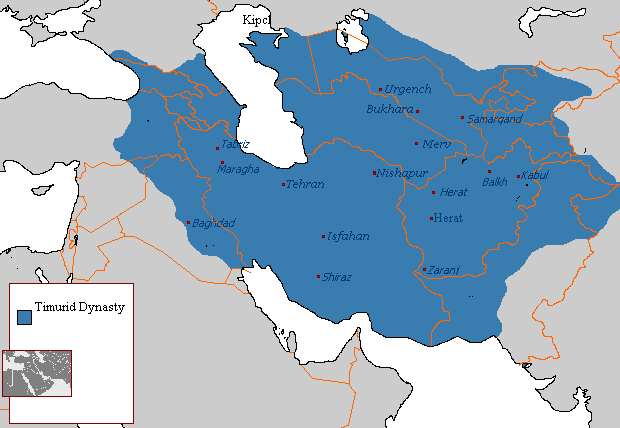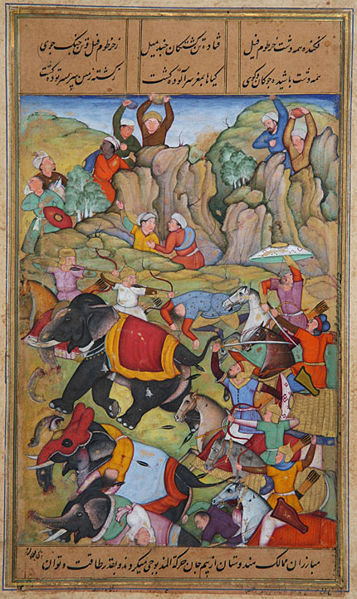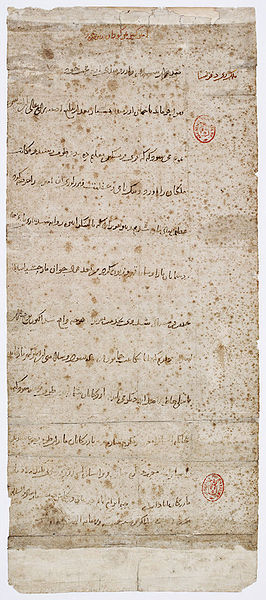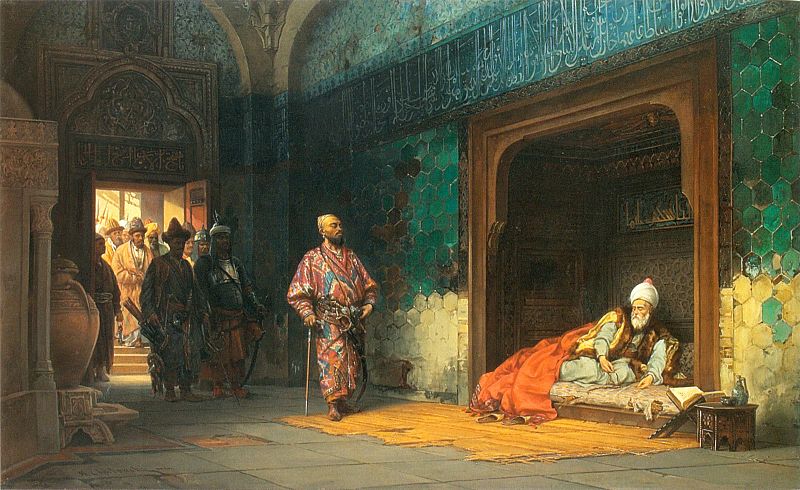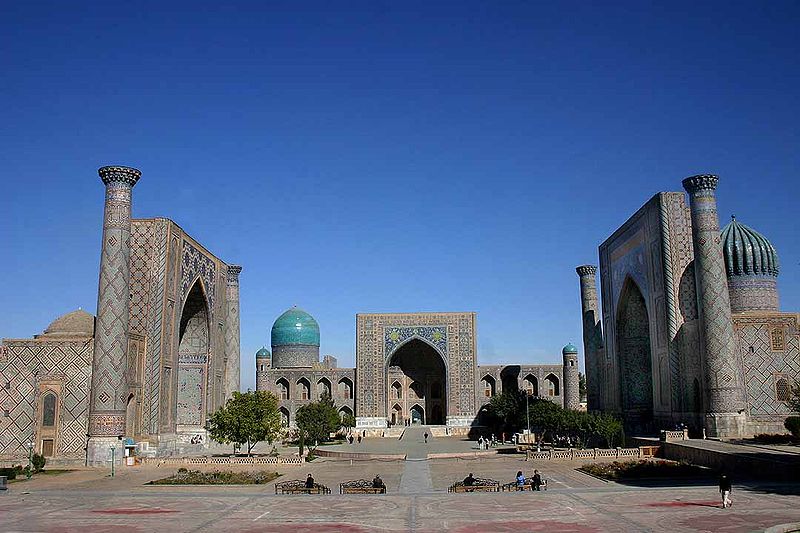<Back to Index>
- Physician William Henry Welch, 1850
- Painter Lodewijk de Vadder, 1605
- Amir of the Timurid Empire Timur (Tamerlane), 1336
PAGE SPONSOR
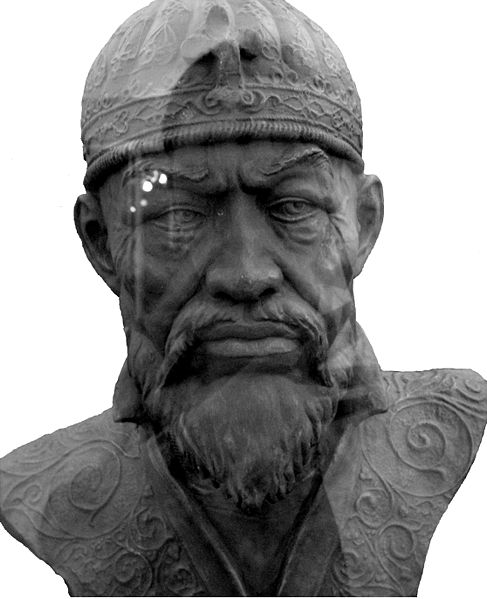
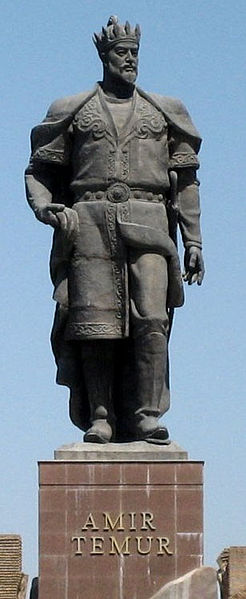
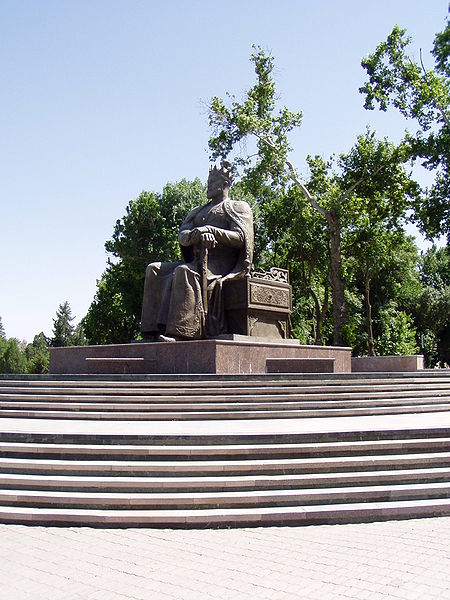
Timur (from Persian: تیمور Timūr, ultimately from Chagatai: Temür "iron"; 8 April 1336 – 18 February 1405), historically known as Tamerlane in English (from Persian: تيمور لنگ, Timūr-e Lang, "Timur the Lame"), was a fourteenth century conqueror of West, South and Central Asia, and the founder of the Timurid dynasty (1370 – 1405) in Central Asia, and great, great grandfather of Babur, the founder of the Mughal Dynasty, which survived as the Mughal Empire in India until 1857.
Timur was in his lifetime a controversial figure, and remains so today. He sought to restore the Mongol Empire, yet his heaviest blow was against the Islamized Tatar Golden Horde. He was more at home in an urban environment than on the steppe. He styled himself a ghazi while conducting wars that severely affected some Muslim states, in particular the Sultanate of Delhi. A great patron of the arts, his campaigns also caused vast destruction.
Temür means "iron" in the Chagatai language. According to the Journal of the Royal Asiatic Society of Great Britain & Ireland (1972) the term temür is possibly derived from a Buddhist Hybrid Sanskrit word *čimara ("iron"). As an adult he was better known as Timūr Gurkānī (تيمور گوركانى), Gurkān being the Persianized form of the original Mongolian word kürügän,
"son - in - law". One of Timur's ancestors who was known by the name
"kara - sharnoban" converted to Islam and married the daughter of Chagatai Khan (son of Genghis Khan). Timur was thus referred to as the son - in - law of Chagatai Khan. Various Persian sources use a byname, Tīmūr-e Lang (تیمور لنگ)
which translates to "Timur the Lame", as he was lame after sustaining
an injury to his foot in battle. During his lifetime his enemies
taunted him with this name, much to Timur's discomfort. In the West, he
is commonly known as Tamerlane,
which derives from his Persian byname. In most of the Asian, especially
Muslim literature, he is regarded as Amir Temur meaning Sultan - the
leader.
Timur was born in Transoxiana, in the City of Kesh (an area now better known as Shahrisabz, "the green city"), some 50 miles south of Samarkand in modern Uzbekistan, then part of the Chagatai Khanate. His father, Taraqai, was a small scale landowner and belonged to the Barlas tribe. The Barlas was a Turko - Mongol tribe which was originally a Mongol tribe and was Turkified and/or became Turkic speaking or intermingling with the Turkic peoples. According to Gérard Chaliand, Timur was a Muslim Turk but he saw himself as Genghis Khan's heir. Though not a Chinggisid, clearly sought to evoke the legacy of Genghis Khan's conquests during his lifetime.
Timur was a Muslim, but while his chief official religious counsellor & advisor was the Hanafite scholar 'Abdu 'l-Jabbar Khwarazmi, his particular persuasion is not known. In Tirmidh, he had come under the influence of his spiritual mentor Sayyid Barakah, a Shiite leader from Balkh who is buried alongside Timur in Gur-e Amir. Despite his Hanafi background, Timur was known to hold Ali and the Shia Imams in high regard and has been noted by various scholars for his "pro-Alid" stance. Despite this, Timur was noted for attacking Shi’is on Sunni grounds and therefore his own religious inclinations remain unclear.
In about 1360 Timur gained prominence as a military leader whose troops were mostly Turkic tribesmen of the region. He took part in campaigns in Transoxiana with the Khan of Chagatai, a fellow descendant of Genghis Khan. His career for the next ten or eleven years may be thus briefly summarized from the Memoirs. Allying himself both in cause and by family connection with Kurgan, the dethroner and destroyer of Volga Bulgaria, he was to invade Khorasan at the head of a thousand horsemen. This was the second military expedition which he led, and its success led to further operations, among them the subjugation of Khorezm and Urganj.
After the murder of Kurgan the disputes which arose among the many claimants to sovereign power were halted by the invasion of the energetic Jagataite Tughlugh Temur of Kashgar, another descendant of Genghis Khan. Timur was dispatched on a mission to the invader's camp, the result of which was his own appointment to the head of his own tribe, the Barlas, in place of its former leader, Hajji Beg.
The
exigencies of Timur's quasi - sovereign position compelled him to have
recourse to his formidable patron, whose reappearance on the banks of
the Syr Darya created
a consternation not easily allayed. The Barlas were taken from Timur
and entrusted to a son of Tughluk, along with the rest of Mawarannahr; but he was defeated in battle by the bold warrior he had replaced at the head of a numerically far inferior force.
Tughlugh's death facilitated the work of reconquest, and a few years of perseverance and energy sufficed for its accomplishment, as well as for the addition of a vast extent of territory. It was in this period that Timur reduced the Chagatai khans to the position of figureheads, who were deferred to in theory but in reality ignored, while Timur ruled in their name. During this period Timur and his brother - in - law Husayn, at first fellow fugitives and wanderers in joint adventures full of interest and romance, became rivals and antagonists. At the close of 1369 Husayn was assassinated and Timur, having been formally proclaimed sovereign at Balkh, mounted the throne at Samarkand, the capital of his dominions. This event was recorded by Marlowe in his famous work Tamburlaine the Great:
Then shall my native city, Samarcanda...
Be famous through the furthest continents,
For there my palace - royal shall be placed,
Whose shining turrets shall dismay the heavens,
And cast the fame of lion's tower to hell.
A legendary account of Timur's rise to leadership, recorded among the Tatar descendants of the Qıpchaq Khanate in Tobol, goes as follows:
One day Aksak Temür spoke thusly:
"Khan Züdei (in China) rules over the city. We now number fifty to sixty men, so let us elect a leader." So they drove a stake into the ground and said: "We shall run thither and he who among us is the first to reach the stake, may he become our leader". So they ran and Aksak Timur (since he was lame) lagged behind, but before the others reached the stake he threw his cap onto it. Those who arrived first said: "We are the leaders". (But) Aksak Timur said: "My head came in first, I am the leader". In the meanwhile an old man arrived and said: "The leadership should belong to Aksak Timur; your feet have arrived but, before then, his head reached the goal". So they made Aksak Timur their prince.
It is notable that Timur never claimed for himself the title of khan, styling himself amir and acting in the name of the Chagatai ruler
of Transoxania. Timur was a military genius but sometimes lacking in
political sense. He tended not to leave a government apparatus behind
in lands he conquered, and was often faced with the need to reconquer
such lands after inevitable rebellions.
Timur spent the next 35 years in various wars and expeditions. He not only consolidated his rule at home by the subjugation of his foes, but sought extension of territory by encroachments upon the lands of foreign potentates. His conquests to the west and northwest led him to the lands near the Caspian Sea and to the banks of the Ural and the Volga. Conquests in the south and south - West encompassed almost every province in Persia, including Baghdad, Karbala and Northern Iraq.
One of the most formidable of Timur's opponents was another Mongol ruler, a descendant of Genghis Khan named Tokhtamysh. After having been a refugee in Timur's court, Tokhtamysh became ruler both of the eastern Kipchak and the Golden Horde. After his accession, he then quarrelled with Timur over the possession of Khwarizm and Azerbaijan. However, Timur still supported him against the Russians and in 1382 Tokhtamysh invaded the Muscovite dominion and burned Moscow.
After the death of Abu Sa'id, ruler of the Ilkhanid Dynasty, in 1335, there was a power vacuum in Persia. In 1383 Timur started the military conquest of Persia. He captured Herat, Khorasan and all eastern Persia by 1385 and captured almost all of Persia by 1387. These conquests were characterised by exceptional brutality. For example, when Isfahan surrendered to Timur in 1387, he initially treated it with relative mercy as he commonly did with cities that surrendered without resistance. However, after the city revolted against Timur's punitive taxes by killing the tax collectors and some of Timur's soldiers, Timur ordered the complete massacre of the city, killing a reported 70,000 citizens. An eye witness counted more than 28 towers, each constructed of about 1,500 heads.
In the meantime, Tokhtamysh, now khan of the Golden Horde, turned against his patron and invaded Azerbaijan in 1385. This action would cause a counter by Timur that would become the Tokhtamysh – Timur war. In the initial stage of the war, Timur won a victory at the Battle of the Kondurcha River, however Tokhtamysh and some of his army were allowed to escape. After Tokhtamysh's initial defeat, Timur then invaded Muscovy to the north of Tokhtamysh's holdings. Timur's army burned Raizan and advanced upon Moscow, only to be pulled away before reaching the Oka River by Tokhtamysh's renewed campaign in the south.
In the first phase of the conflict with Tokhtamysh, Timur led an army of over 100,000 men north for more than 700 miles into the uninhabited steppe, then west about 1,000 miles, advancing in a front more than 10 miles wide. The Timurid army almost starved, and Timur organized a great hunt where the army encircled vast areas of steppe to get food. It was then that Tokhtamysh's army was boxed in against the east bank of the Volga River in the Orenburg region and destroyed at the previously mentioned Battle of the Kondurcha River. During this march, Timur's army got far enough north to be in a region of very long summer days, causing complaints by his Muslim soldiers about keeping a long schedule of prayers in such northern regions.
It was in the second phase of the conflict that Timur took an easier route against the enemy, invading the realm of Tokhtamysh via the Caucasus region. The year 1395, saw the Battle of the Terek River, when Tokhtamysh's power was finally broken, concluding the titanic struggle between the two monarchs.
Tokhtamysh was not able to restore his power or prestige. He was killed about a decade after the Terek River battle in the area of present day Tyumen, by agents of an emir named Edigu.
Timur during the course of his campaigns destroyed Sarai, the capital of the Golden Horde, and Astrakhan, subsequently wrecking the Golden Horde's economy based on Silk Road trade. The Golden Horde saw political disintegration after such losses, with Mongol unity in the region shattered permanently.
In May 1393 Timur invaded the Anjudan, crippling the Ismaili village only one year after his assault on the Ismailis in Mazandaran. The village appears to have been prepared for attack, as it contained a fortress and an intricate system of underground tunnels. These devices were, however, unsuccessful in thwarting Timur’s soldiers, who flooded the tunnels by cutting into a channel overhead. Timur’s reasons for attacking this village are not yet well understood, however it has been suggested that his religious persuasions and view of himself as an executor of divine will may have contributed to his motivations. The Persian historian Khwandamir explains that an Ismaili presence was growing more politically powerful in Persian Iraq. A group among the locals in this region was dissatisfied with this. Khwandamir writes that some of these locals assembled and brought up their complaint with Timur, possibly provoking his attack on the Ismailis there.
In 1398 Timur invaded northern India, attacking the Delhi Sultanate ruled by Sultan Nasir-u Din Mehmud of the Tughlaq Dynasty. The cambridge history says that he was opposed by Ahirs and Jats but Delhi Government did nothing to stop him. He crossed the Indus river on September 30, 1398 and captured Multan by October.
His campaign was officially justified by claims that the Muslim Delhi Sultanate was too tolerant toward its Hindu subjects, but was motivated greatly by the considerable wealth to be gained. By all accounts, Timur's campaigns in India were marked by systematic slaughter and other atrocities on a truly massive scale inflicted mainly on the subcontinent's Hindu population.
Timur crossed the Indus River at Attock (now Pakistan) on September 24, 1398, but Timur's invasion did not go unopposed and he did meet some resistance during his march to Delhi, by the Governor of Meerut.
Timur was able to continue his relentless approach to Delhi, arriving
in 1398 to combat the armies of Sultan Mehmud, already weakened by a
succession struggle within the royal family.
The Sultan's army was easily defeated on December 17, 1398. On this day the army of Sultan Mahmud Khan had prepared 120 war elephants armored with chain mail. He had put poison on the tusks, which put fright into the Tatar lines. Timur took action and the Tatars dug out a trench in front of their positions. Timur then took his camels and placed all the wood and hay he could on their backs. When the war elephants charged he lit the camels on fire and then prodded them with iron sticks. They charged at the elephants howling in pain: Timur had understood that elephants were easily panicked. Faced with the strange spectacle of the burning camels flying straight at them with flames leaping from their backs, the elephants turned around and stampeded back toward their own lines. Timur entered Delhi and the city was sacked, destroyed, and left in ruins. Before the battle for Delhi, Timur executed 100,000 captives, mostly Hindus:
"At this Court Amír Jahán Sháh and Amír Sulaimán Sháh, and other amírs of experience, brought to my notice that, from the time of entering Hindustán up to the present time, we had taken more than 100,000 infidels and Hindu prisoners, and that they were all in my camp. On the previous day, when the enemy's forces made the attack upon us, the prisoners made signs of rejoicing, uttered imprecations against us, and were ready, as soon as they heard of the enemy's success, to form themselves into a body, break their bonds, plunder our tents, and then to go and join the enemy, and so increase his numbers and strength. I asked their advice about the prisoners, and they said that on the great day of battle these 100,000 prisoners could not be left with the baggage, and that it would be entirely opposed to the rules of war to set these idolaters and foes of Islám at liberty. In fact, no other course remained but that of making them all food for the sword. When I heard these words I found them in accordance with the rules of war, and I directly gave my command for the Tawáchís to proclaim throughout the camp that every man who had infidel prisoners was to put them to death, and whoever neglected to do so should himself be executed and his property given to the informer. When this order became known to the gházís of Islám, they drew their swords and put their prisoners to death. 100,000 infidels, impious idolaters, were on that day slain. Mauláná Násiru-d dín 'Umar, a counsellor and man of learning, who, in all his life, had never killed a sparrow, now, in execution of my order, slew with his sword fifteen idolatrous Hindus, who were his captives."
The alleged "Memoirs" of Timur, or Tuzk-e-Taimuri, relate the sack of Delhi:
"On the 16th of the month some incidents occurred which led to the sack of the city of Delhí, and to the slaughter of many of the infidel inhabitants. One was this. A party of fierce Turk soldiers had assembled at one of the gates of the city to look about them and enjoy themselves, and some of them laid violent hands upon the goods of the inhabitants. When I heard of this violence, I sent some amírs, who were present in the city, to restrain the Turks. A party of soldiers accompanied these amírs into the city. Another reason was that some of the ladies of my harem expressed a wish to go into the city and see the palace of Hazár - sutún (thousand columns) which Malik Jauná built in the fort called Jahán - panáh. I granted this request, and I sent a party of soldiers to escort the litters of the ladies. Another reason was that Jalál Islám and other díwáns had gone into the city with a party of soldiers to collect the contribution laid upon the city. Another reason was that some thousand troopers with orders for grain, oil, sugar, and flour, had gone into the city to collect these supplies. Another reason was that it had come to my knowledge that great numbers of Hindus and gabrs, with their wives and children, and goods, and valuables, had come into the city from all the country round, and consequently I had sent some amírs with their regiments (kushún) into the city and directed them to pay no attention to the remonstrances of the inhabitants, but to seize and bring out these fugitives. For these several reasons a great number of fierce Turkí soldiers were in the city. When the soldiers proceeded to apprehend the Hindus and gabrs who had fled to the city, many of them drew their swords and offered resistance. The flames of strife were thus lighted and spread through the whole city from Jahán - panáh and Sírí to Old Dehlí, burning up all it reached. The savage Turks fell to killing and plundering. The Hindus set fire to their houses with their own hands, burned their wives and children in them, and rushed into the fight and were killed. The Hindus and gabrs of the city showed much alacrity and boldness in fighting. The amírs who were in charge of the gates prevented any more soldiers from going into the place, but the flames of war had risen too high for this precaution to be of any avail in extinguishing them. On that day, Thursday, and all the night of Friday, nearly 15,000 Turks were engaged in slaying, plundering, and destroying. When morning broke on the Friday, all my army, no longer under control, went off to the city and thought of nothing but killing, plundering, and making prisoners. All that day the sack was general. The following day, Saturday, the 17th, all passed in the same way, and the spoil was so great that each man secured from fifty to a hundred prisoners, men, women, and children. There was no man who took less than twenty. The other booty was immense in rubies, diamonds, garnets, pearls, and other gems; jewels of gold and silver; ashrafís, tankas of gold and silver of the celebrated 'Aláí coinage; vessels of gold and silver; and brocades and silks of great value. Gold and silver ornaments of the Hindu women were obtained in such quantities as to exceed all account. Excepting the quarter of the saiyids, the 'ulamá, and the other Musulmáns, the whole city was sacked. The pen of fate had written down this destiny for the people of this city. Although I was desirous of sparing them I could not succeed, for it was the will of Allah that this calamity should fall upon the city."
Timur left Delhi in December 1398 and marched on Meerut. Then he rode up to Haridwar and sacked the holy city on January 23, 1399. Before he crossed the Ganges, he faced stiff resistance from Hindus at Bhokarhedi. In April he had returned to his own capital beyond the Oxus (Amu Darya). Immense quantities of spoils and slaves were taken from India. According to Ruy Gonzáles de Clavijo, 90 captured elephants were employed merely to carry precious stones looted from his conquest, so as to erect a mosque at Samarkand – what historians today believe is the enormous Bibi - Khanym Mosque.
Before the end of 1399, Timur started a war with Bayezid I, sultan of the Ottoman Empire, and the Mamluk sultan of Egypt. Bayezid began annexing the territory of Turkmen and Muslim rulers in Anatolia. As Timur claimed sovereignty over the Turkmen rulers, they took refuge behind him. Timur invaded Syria, sacked Aleppo and captured Damascus after defeating the Mamluk army. The city's inhabitants were massacred, except for the artisans, who were deported to Samarkand. This led to Timur's being publicly declared an enemy of Islam, as he was no longer killing only non - Muslims. However, Ibn Khaldun praises Timur for having unified much of the Muslim world when other conquerors of the time could not.
In a form of rectification, in 1400 Timur invaded Christian Armenia and Georgia. Of the surviving population, more than 60,000 of the local people were captured as slaves, and many districts were depopulated.
He invaded Baghdad in June 1401. After the capture of the city, 20,000 of its citizens - Muslims - were massacred. Timur ordered that every soldier should return with at least two severed human heads to show him (many warriors were so scared they killed prisoners captured earlier in the campaign just to ensure they had heads to present to Timur).
In the meantime, years of insulting letters had passed between Timur and Bayezid. Finally, Timur invaded Anatolia and defeated Bayezid in the Battle of Ankara on July 20, 1402. Bayezid was captured in battle and subsequently died in captivity, initiating the 12 year Ottoman Interregnum period. Timur's stated motivation for attacking Bayezid and the Ottoman Empire was the restoration of Seljuq authority. Timur saw the Seljuks as the rightful rulers of Anatolia as they had been granted rule by Mongol conquerors, illustrating again Timur's interest with Genghizid legitimacy.
After the Ankara victory, Timur's army ravaged Western Anatolia, with Muslim writers complaining that the Timurid army acted more like a horde of savages than that of a civilized conqueror. But Timur did take the city of Smyrna, a stronghold of the Christian Knights Hospitalers, thus he referred to himself as ghazi or "Warrior of Islam".
Timur was furious at the Genoese and Venetians whose ships ferried the Ottoman army to safety in Thrace. As Lord Kinross reported in The Ottoman Centuries, the Italians preferred the enemy they could handle to the one they could not.
By 1368, the new Chinese Ming Dynasty had driven the Mongols out of China. The first Ming Emperor Hongwu, and his successor Yongle demanded, and received, homage from many Central Asian states as the political heirs to the former House of Kublai. The Ming emperor's attempts to treat Timur as a vassal did not go well: when in 1394 Hongwu's ambassadors presented Timur with a letter addressing him in this way, he had the ambassadors Fu An, Guo Ji, and Liu Wei detained, and their 1,500 guards executed. Neither Hongwu's next ambassador, Chen Dewen (1397) nor the delegation announcing the accession of the Yongle Emperor fared any better.
Timur eventually planned to conquer China. To this end, Timur made an alliance with the Mongols of the Northern Yuan Dynasty and prepared all the way to Bukhara. The Mongol leader Enkhe Khan sent his grandson Öljei Temür, also known as Buyanshir Khan. In December 1404, Timur started military campaigns against the Ming Dynasty and detained the Ming envoy, but he was attacked by fever and plague when encamped on the farther side of the Sihon (Syr - Daria) and died at Atrar (Otrar) on February 17, 1405, without ever reaching the Chinese border. Only after that were the Ming envoys released.
Timur's scouts explored Mongolia before
his death, and the writing they carved on trees in Mongolia's mountains
could still be seen even in the twentieth century.
Although he preferred to fight his battles in the spring, Timur died enroute during an uncharacteristic winter campaign against the ruling Chinese Ming Dynasty. It was one of the bitterest winters on record; his troops are recorded as having to dig through five feet of ice to reach drinking water. Records indicate though, that for part of his life at least, he was a surreptitious Ming vassal and that his son Shah Rukh visited China in 1420. He ruled over an empire that, in modern times, extends from southeastern Turkey, Syria, Iraq, Kuwait and Iran, through Central Asia encompassing part of Kazakhstan, Afghanistan, Armenia, Azerbaijan, Georgia, Turkmenistan, Uzbekistan, Kyrgyzstan, Pakistan, North - Western India, and even approaches Kashgar in China. The conquests of Timur are claimed to have caused the deaths of up to 17 million people; an opinion impossible to verify. Timur's campaigns sometimes caused large and permanent demographic changes, northern Iraq remained predominantly Assyrian Christian until attacked, looted, plundered and destroyed by Timur leaving its population decimated by systematic mass slaughter.
Of Timur's four sons, two (Jahangir and Umar Shaykh) predeceased him. His third son, Miran Shah, died soon after Timur, leaving the youngest son, Shah Rukh. Although his designated successor was his grandson Pir Muhammad b. Jahangir, Timur was ultimately succeeded in power by his son Shah Rukh. His most illustrious descendant Babur founded the Islamic Mughal Empire and ruled over most of Afghanistan and North India. Babur's descendants Humayun, Akbar, Jahangir, Shah Jahan and Aurangzeb, expanded the Mughal Empire to most of the Indian subcontinent.
Markham,
in his introduction to the narrative of Clavijo's embassy, states that
his body "was embalmed with musk and rose water, wrapped in linen, laid
in an ebony coffin and sent to Samarkand, where it was buried." His tomb, the Gur-e Amir, still stands in Samarkand, though it has been heavily restored in recent years.
Timur became widely known as a patron to the arts. Much of the architecture he commissioned still stands in Samarkand, now in present day Uzbekistan. He was known to bring the most talented artisans from the lands he conquered back to Samarkand, and is credited with often giving them a wide latitude of artistic freedom to express themselves. He also constructed one of his finest buildings at the tomb of Ahmed Yesevi, an influential Turkic Sufi saint who spread Sufi Islam among the nomads.
According to legend, Omar Aqta, Timur's court calligrapher, transcribed the Qur'an using letters so small that the entire text of the book fit on a signet ring. Omar also is said to have created a Qur'an so large that a wheelbarrow was required to transport it. Folios of what is probably this larger Qur'an have been found, written in gold lettering on huge pages.
Timur was also said to have created Tamerlane Chess, a variant of shatranj (also known as medieval chess) played on a larger board with several additional pieces and an original method of pawn promotion. These pieces included the camel, siege weapon, giraffe, and several others as well as boasting a complicated system involving the ability to exchange pawns for certain pieces should they reach the other side of the board.
Timur's mandating of Kurash wrestling
for his soldiers ensured for it a lasting and legendary legacy. Kurash
is now a popular international sport and part of the Asian Games.
Timur had numerous epistolary and diplomatic exchanges with Western, especially Spanish and French, rulers. There was the possibility of an alliance between Timur and the European states, against the Ottoman Turks that were attacking Europe. Therefore, there was a clear motive for Timur, who wanted to surround his Ottoman and Mamluk enemies in this offensive alliance.
The relations between the courts of Henry III of Castile and that of Timur constituted the most important episode of the medieval Spanish Castilian diplomacy. In 1402, the time of the Battle of Ankara, two Spanish ambassadors were already with Timur: Pelayo de Sotomayor and Fernando de Palazuelos. Later, Timur sent to the court of Castile and León a Chagatay ambassador named Hajji Muhammad al-Qazi with letters and gifts.
In return, the King Henry III of Castile sent a famous embassy to Timur's court in Samarqand in 1403 - 06, led by Ruy Gonzales de Clavijo, with two other ambassadors, Alfonso Paez and Gomez de Salazar. On their return, Timur affirmed that he regarded the king of Castile "as his very own son".
According to Clavijo, Timur's good treatment of the Spanish delegation contrasted with the disdain shown by his host toward the envoys of the "lord of Cathay" (i.e., the Ming Dynasty Yongle Emperor), the Chinese ruler. Clavijo's visit to Samarkand allowed him to report to the European audience on the news from Cathay (China), which few Europeans had been able to visit directly in the century that had passed since the travels of Marco Polo.
On the other hand, the French archives preserve:
- A July 30, 1402, letter from Timur to Charles VI, king of France, suggesting him to send traders to the Orient. It was written in Persian.
- A May 1403 letter. This is a Latin transcription of a letter from Timur to Charles VI, and another from Amiza Miranchah, his son, to the Christian princes, announcing their victory over Bayezid, in Smyrna.
A copy has been kept of the answer of Charles VI to Timur, dated June 15, 1403.
I am not a man of blood; and God is my witness that in all my wars I have never been the aggressor, and that my enemies have always been the authors of their own calamity.
Timur's legacy is a mixed one. While Central Asia blossomed under his reign, other places such as Baghdad, Damascus, Delhi and other Arab, Persian and Indian cities were sacked and destroyed and their populations massacred. He was responsible for the effective destruction of the Christian Church in much of Asia. Thus, while Timur still retains a positive image in Muslim Central Asia, Persia, and Arab countries, he is vilified by many in India, where some of his greatest atrocities were carried out. In the Islamic world at the time, he was variously considered both as a ghazi (or "Warrior for Islam") by some, and as an enemy of Islam by others.
Timur's military talents were unique. He planned all his campaigns years in advance, even planting barley for horse feed two years ahead of his campaigns. He used propaganda, in what is now called information warfare, as part of his tactics. His campaigns were preceded by the deployment of spies whose tasks included collecting information and spreading horrifying reports about the cruelty, size, and might of Timur’s armies. Such psychological warfare eventually weakened the morale of threatened populations and caused panic in the regions that he intended to invade.
Whilst Timur's uncharacteristic (for the time) concern for his troops inspired fierce loyalty, he did not pay them. Their only incentives were from looting captured territory — a bounty that included horses, women, precious metals and stones; in other words whatever they, or their newly captured slaves, could carry away from the conquered lands.
Timur's short lived empire also melded the Turko - Persian tradition in Transoxiania, and in most of the territories which he incorporated into his fiefdom, Persian became the primary language of administration and literary culture (diwan), regardless of ethnicity. In addition, during his reign, some contributions to Turkic literature were penned, with Turkic cultural influence expanding and flourishing as a result. A literary form of Chagatai Turkic came into use alongside Persian as both a cultural and an official language.
Timur became a relatively popular figure in Europe for centuries after his death, mainly because of his victory over the Ottoman Sultan Bayezid. The Ottoman armies were at the time invading Eastern Europe and Timur was ironically seen as a sort of ally.
Timur has now been officially recognized as a national hero of newly independent Uzbekistan. His monument in Tashkent now occupies the place where Marx's statue once stood.
Timur's generally recognized biographers are Ali Yazdi, commonly called Sharaf ud-Din, author of the Zafarnāmeh in Persian (ظفرنامه), translated by Petis de la Croix in 1722, and from French into English by J. Darby in the following year; and Ahmad ibn Muhammad ibn Abdallah, al-Dimashiqi, al-Ajami (commonly called Ahmad Ibn Arabshah) translated by the Dutch Orientalist Colitis in 1636. In the work of the former, as Sir William Jones remarks, "the Tatarian conqueror is represented as a liberal, benevolent and illustrious prince", in that of the latter he is "deformed and impious, of a low birth and detestable principles." But the favourable account was written under the personal supervision of Timur's grandson, Ibrahim, while the other was the production of his direst enemy.
Among less reputed biographies or materials for biography may be mentioned a second Zafarnāmeh, by Nizam al-Din Shami, stated to be the earliest known history of Timur, and the only one written in his lifetime. Timur's purported autobiography, the Tuzk - e - Taimuri ("Memoirs of Temur") is a later fabrication, although most of the historical facts are accurate.
More recent biographies include Justin Marozzi's Tamerlane: Sword of Islam, Conqueror of the World (2006) and Roy Stier's Tamerlane: The Ultimate Warrior (1998).
Timur's body was exhumed from his tomb in 1941 by the Soviet anthropologist Mikhail M. Gerasimov. From his bones it was clear that Timur was a tall and broad chested man with strong cheek bones. Gerasimov reconstructed the likeness of Timur from his skull. His height was 5 feet 8 inches (1.73 meters), tall for his era. He also confirmed Timur's lameness due to a hip injury.
It
is alleged that Timur's tomb was inscribed with the words: "When I rise
from the dead, the world shall tremble." It is also said that when
Gerasimov exhumed the body, an additional inscription inside the casket
was found reading: "Who ever opens my tomb, shall unleash an invader
more terrible than I". In any case, two days after Gerasimov had begun the exhumation, Nazi Germany launched Operation Barbarossa, its invasion of the U.S.S.R. Timur was re-buried with full Islamic ritual in November 1942 just before the Soviet victory at the Battle of Stalingrad.
